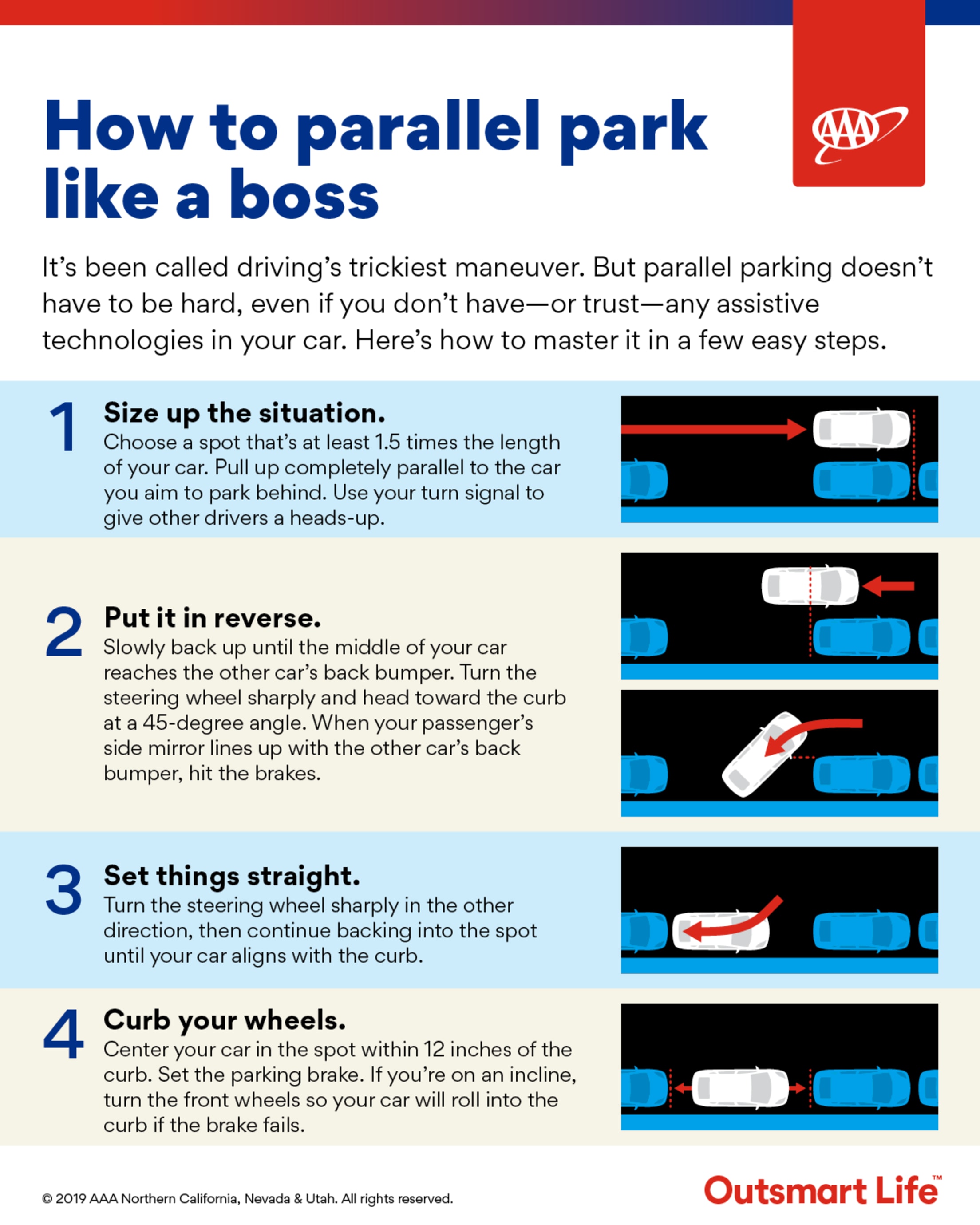
How to Parallel Park
Learn how to parallel park in four easy steps—really!

Congratulations! You’ve found a parking spot. Your next challenge: backing your vehicle into it. Parallel parking is a specialized skill that many people avoid at all costs, but the benefits it provides make the process well worth learning. There’s no reason you should have to pass on a convenient place to park.
Getting a handle on parallel parking takes some practice. These simple tactics and techniques should help. Check out the infographic below for a useful visual aid.
Steps to Successfully Parallel Park
“Not all vehicles are created equal,” says Mike Gillespie, an Arizona-based Club Trainer and driving educator at AAA. Though you don’t need to memorize every single spec, you should know your vehicle’s length and width (that information is in the owner’s manual) and familiarize yourself with its steering radius and any blindspots. “The better your understanding of what you’re driving, the easier it will be for you to park,” Gillespie says.
1. Pick your spot.
If the first spot you find looks tight, don’t feel compelled to take it. Better to search for an easier fit. This depends in part on your parallel parking skills, but as a general rule, opt for a spot that’s at least 1.5 times the length of your car. “I know they call them bumpers, but you don’t want to bump into the other cars as you’re parking,” Gillespie says. “Not only is it illegal to make contact with another vehicle, so many cars these days have alarms and airbags that you can trigger with even gentle contact.”
Once you’ve determined your spot, pull parallel to the car parked at the front of your desired space, 2 to 3 feet from its side, and turn on your blinker to alert traffic behind you that you’re getting ready to back in.
2. Time to reverse.
Before you back up, check your mirrors. Not just the rearview, but the side-view mirrors too. Sit up tall to minimize any potential blindspots. As an extra precaution, look over your shoulder on both sides to ensure that the coast is clear. If there’s traffic behind you, use hand signals to wave the cars to go around.
Shift into reverse and start backing up while looking over your right shoulder toward the parking space. Proceed slowly, preferably controlling your velocity with the brake and not the accelerator. When the middle of your car is roughly even with the rear bumper of the car beside you, turn the wheel to the right until your vehicle is at a 45-degree angle to the curb. A good rule of thumb? Move slowly but turn quickly.
Keep backing up at an angle until your passenger’s side mirror is aligned with the other car’s back bumper, then stop.

Look over your shoulder on both sides before you begin to back up.
3. Straighten out.
Turn your wheel the other direction, then continue backing up until your front end has cleared the vehicle in front of you and your car is parallel to the curb.
When your inside rear wheel is about a foot from the curb, and the rear of your vehicle is still a few feet from the vehicle behind you, stop. Shift into drive and move forward slowly, straightening your vehicle as you do.
4. Even things out.
If, as you’re backing up, your tire hits the curb, pull forward and then back up again, turning your wheel at a sharper angle to adjust. Laws for how close your wheels must be to the curb vary from state to state, but as a safe rule of thumb, center your car within 12 inches of the curb. If there is no curb, align your car so that it’s parallel to the street.
Aim to leave an equal amount of space between you and the cars in front and back of you to give them as much room as possible to get out. If you’ve parked on a hill, facing downhill, turn your front wheels toward the curb to prevent a runaway; if you’re facing uphill, turn your front wheels away from the curb.

How to Exit Safely
When exiting a tight spot into traffic, do everything you can to make sure you are seen. “Turn on your blinker, roll down your window, and use friendly hand signals, making eye contact with drivers behind you,” Gillespie says. “You might wave them to go around you, but they also might be polite and patient and wait for you.”
Before opening your door, it’s also important to look out for cyclists, especially in big cities where bike lanes proliferate. A good precautionary measure is known as the Dutch Reach, so named because it originated in the Netherlands. This simple method involves reaching across your body with your right hand to open the driver’s side door, rather than opening the door with your left hand. Doing so naturally prompts you to turn and look over your shoulder, making you aware of any oncoming cyclists. By making this a habit, you can help make the roads safer for everyone.
Practice Makes Perfect
When it comes to learning how to parallel park, there’s nothing better than repetition. An ideal place to practice is an empty parking lot, using four cones or plastic pylons (these can be rented at most car rental shops) to simulate a rectangular-shaped parking spot by placing a cone or pylon at each corner. The dimensions should be about one foot wider than the width of your car, and one-and-half the length of your car. Practice the steps above, making sure to park without bumping into the cones or pylons.
When you’re parallel parking for real, you’ll need to be cautious to avoid contact with the bumpers of the other parked cars. If you do hit another car while you’re exiting a spot—yes, even a small “tap” counts—the law in most states requires you to leave a note with your name and contact information. If you’re borrowing a car, you’ll also need to provide the owner’s information. It’s wise to snap a cell phone photo of any damage so you have it for your records.
Make smart choices, whether you're buying, selling, insuring, maintaining, or repairing a vehicle.